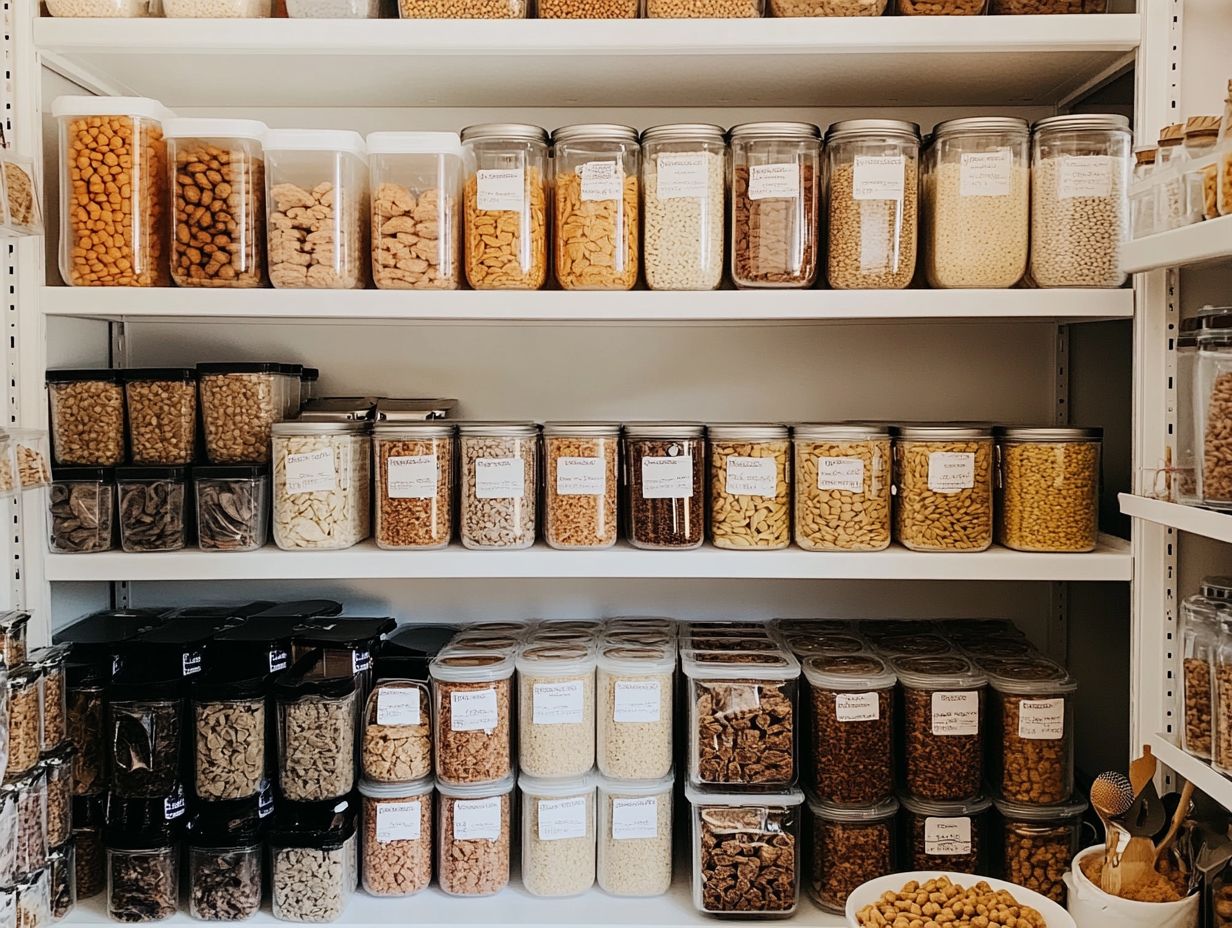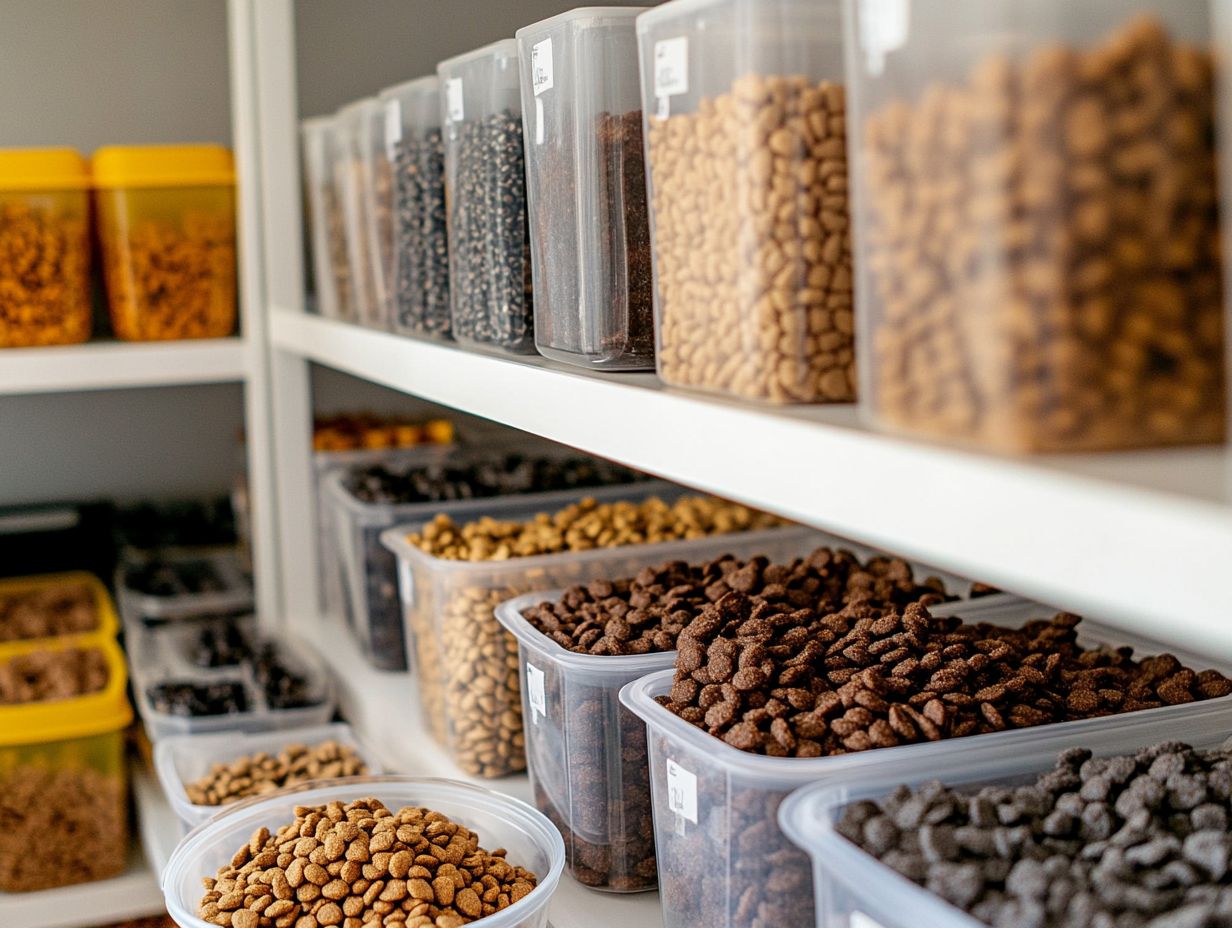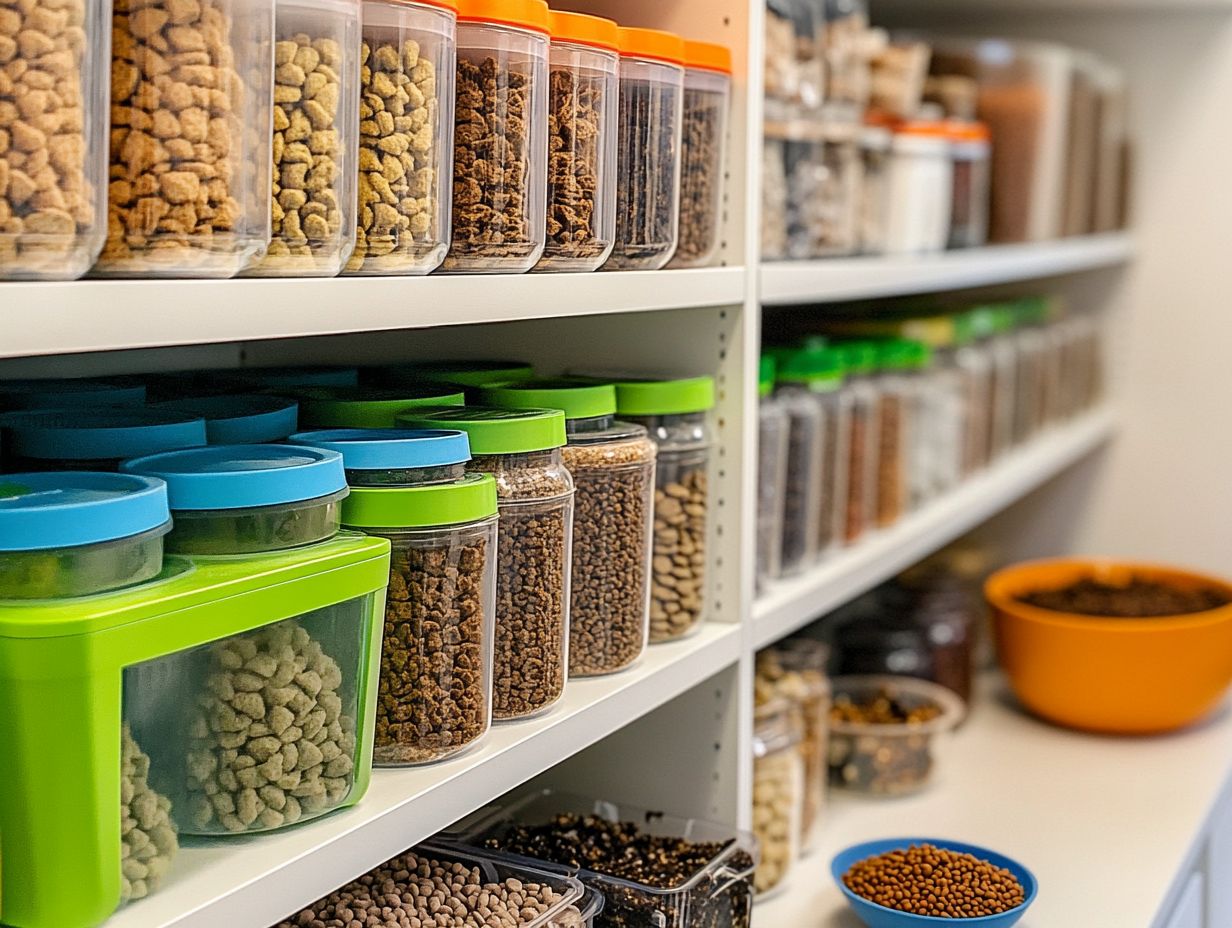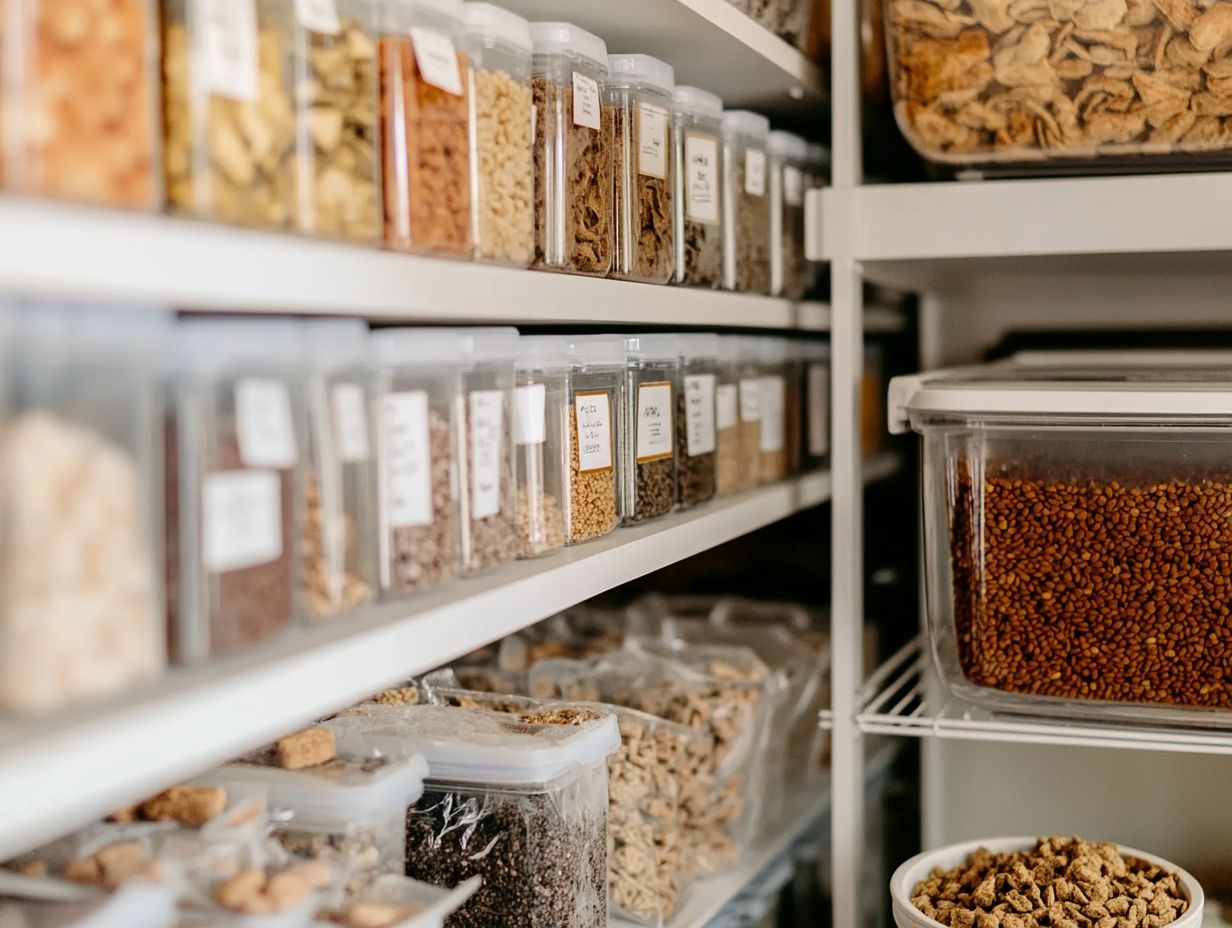If you’re a cat or dog owner, you understand the importance of providing your furry friend with a nutritious diet that meets their specific needs. Cats are obligate carnivores, requiring animal-source proteins to thrive. Thus, ensuring a diet rich in these essential nutrients is crucial for their health.
Freeze-dried cat food and dry cat food have gained popularity as convenient and healthful options, but what exactly are they?
This article explores what freeze-dried cat food is, how it’s made using advanced cooking techniques, and its benefits and drawbacks. Please consult a veterinarian before transitioning to freeze-dried or any alternative diets, particularly if your cat has special dietary needs such as kidney disease or diabetes.
It also shares essential tips for storing it to maintain freshness, ensuring your cat enjoys every bite. Discover how to make informed choices for your pet’s diet, whether you prefer wet cat food or dry cat food!
Key Takeaways:

- Store freeze-dried cat food in a cool, dry place between 50°F to 70°F (10°C to 21°C) and use oxygen absorbers to maintain maximum freshness.
- Use airtight storage containers like glass jars and food-grade containers, and avoid exposure to sunlight and moisture.
- Rotate your stock and check for signs of spoilage or rancid food by looking for discoloration or an off smell to ensure the safety and health of your cat.
What Is Freeze-Dried Cat Food?
Freeze-dried cat food is a specialized type of pet food that preserves essential nutrients while offering convenience in storage and preparation for cat owners. The process of freeze-drying removes moisture from the food, extending its shelf life without compromising the flavors and textures that cats enjoy.
Prominent brands such as K9 Natural, Feline Natural, and Science Diet provide options that cater to various dietary needs, effectively supporting pet health, but it’s essential to ensure they meet AAFCO standards.
How Is Freeze-Dried Cat Food Made?
The preparation of freeze-dried cat food involves advanced cooking techniques that prioritize food preservation and safety, which are crucial for minimizing the risk of contamination from harmful bacteria such as Salmonella and E. coli.
This process employs freezing and vacuum technology to remove moisture without altering the food’s structure, texture, or taste. Initially, the cat food is frozen at extremely low temperatures, causing its water content to turn into ice. It is then placed under a vacuum, allowing the ice to sublimate—transitioning directly from solid to gas—resulting in a lightweight, shelf-stable product.
By eliminating 98% of the moisture, these techniques significantly extend the food’s shelf life and enhance food safety by preventing the growth of harmful microorganisms. Consequently, pet owners can serve their pets meals rich in essential flavors and nutrients.
What Are the Benefits of Freeze-Dried Cat Food?
Freeze-dried cat food offers several advantages, including improved nutrient retention, convenient storage, and flexible feeding options. These qualities make it an ideal choice for pet owners who prioritize their pets’ health.
1. Retains Nutritional Value
The primary advantage of freeze-dried cat food is that it retains its nutritional value due to the cooking process, which minimizes nutrient loss. However, potential nutritional deficiencies compared to traditional wet or raw diets may occur. To mitigate these deficiencies, consider supplementation or veterinary guidance.
2. Easy to Store and Transport
Freeze-dried cat food is designed for easy storage and transport, making it an ideal option for cat owners on the go when kept in airtight containers. These containers protect the food from moisture and air, preventing rancidity and allowing it to be stored for extended periods without losing quality.
By using high-quality food storage containers, owners can ensure their cats receive nutritious meals that taste great and retain their health benefits for as long as possible. Additionally, these containers are convenient for short trips, whether it’s a weekend getaway or a visit to a friend’s house, allowing busy owners to provide their cats with healthy food options even when they are away from home.
They come in various sizes and flexible options, making storage effortless.
3. Safe for Sensitive Cats
Freeze-dried cat food is often a safe choice for sensitive cats, as it minimizes the risk of food contamination from bacteria such as E. coli while providing essential nutrients. This type of food retains the vitamins and minerals crucial for a healthy feline lifestyle, making it easier for owners to manage their pets’ dietary needs.
Key Nutritional Considerations
Different life stages (kittens, adults, seniors) require unique dietary requirements. Always choose products that are formulated for your cat’s specific life stage to ensure they are meeting their nutritional needs.
Ethical and Sustainability Considerations
When selecting freeze-dried cat food, consider the sourcing of animal proteins to ensure it aligns with ethical practices without compromising your cat’s health.
Recognizing Spoilage
To ensure your freeze-dried cat food remains safe, look for visual and olfactory indicators of spoilage, such as:
- Unusual discoloration
- Off or rancid odors
- Moisture or clumping in the food
Adhere to current feeding guidelines provided by organizations such as AAFCO and WSAVA for further reading.
Additionally, freeze-dried options reduce the likelihood of allergic reactions associated with certain ingredients, such as corn, wheat, and soy, which can be particularly challenging for cats with food sensitivities. By choosing this diet, pet owners can ensure their furry companions receive balanced, high-quality nutrition without the concern of harmful additives. However, it is essential to consult with a veterinarian before making dietary changes, especially for cats with specific health conditions or dietary sensitivities.
Moreover, the palatability of freeze-dried meals often encourages hesitant eaters to enjoy their food, promoting better overall health and vitality. It’s important to remember that the dietary needs of cats may vary based on their life stages, such as kittens, senior cats, or pregnant and nursing cats, and freeze-dried diets may or may not meet those specific nutritional requirements.
What Are the Drawbacks of Freeze-Dried Cat Food?

The disadvantages of freeze-dried cat food include its higher cost compared to traditional pet food and the limited variety of flavors available.
1. More Expensive Than Traditional Cat Food
One of the major disadvantages of freeze-dried cat food is that it is more expensive than most other types of pet food, which can often be a deciding factor for pet owners. This price difference may leave many owners uncertain about whether to purchase freeze-dried options.
Unlike regular cat food, which is often mass-produced with many fillers, freeze-dried cat food is made through a more complex process that removes water while preserving nutrients. Although this process results in higher ingredient quality, it also incurs greater production costs. Additionally, the need for high-quality meat and vegetables—essential for obtaining the health benefits of freeze-dried food—contributes to the elevated price. Pet owners must take this into account when adjusting their budgets and considering their pets’ nutritional needs.
2. Limited Variety of Flavors
One drawback of freeze-dried cat food is its limited variety of flavors, which may not satisfy the preferences and dietary needs of all cats. This limitation can significantly affect both a cat’s enjoyment and an owner’s choices. Cats are obligate carnivores and may have specific protein sources they prefer, making a broad flavor selection essential for ensuring both enjoyment and nutritional balance.
Cats are known to be finicky eaters, and a narrow flavor selection can result in disinterest. This can frustrate owners who wish to cater to their cats’ tastes while also providing nutritious options. Additionally, a restricted flavor range can lead to monotonous feeding patterns, diminishing a cat’s enjoyment of food and potentially impacting their overall well-being.
How to Store Freeze-Dried Cat Food for Maximum Freshness
Proper storage of freeze-dried cat food is essential for maximizing freshness and preventing spoilage. To achieve this, using appropriate storage solutions, such as airtight containers, is recommended. Be sure to check for any signs of spoilage, such as odors or changes in texture, as these can indicate compromised quality.
1. Keep it in a Cool, Dry Place
To ensure that freeze-dried cat food remains fresh for as long as possible, it should be stored in a cool, dry place, away from sunlight and moisture. This helps prevent fluctuations in temperature and high humidity, which can lead to increased degradation of the food.
2. Use Airtight Containers
Airtight containers play a crucial role in storing freeze-dried cat food by preventing air exposure, which can lead to rancidity and degradation of nutritional quality. These containers come in various types, including vacuum-sealed bags, opaque jars, and heavy-duty plastic bins, each offering unique advantages in protecting their contents from moisture and oxygen.
Vacuum-sealed bags are particularly effective at minimizing air pockets, while opaque jars block light, which can also compromise food quality. Heavy-duty bins with secure locking mechanisms are ideal for bulk storage, ensuring that every morsel is preserved for as long as possible.
Choosing the right type of airtight container can significantly extend the shelf life of freeze-dried food while maintaining the flavor and nutrients essential for a healthy diet.
3. Avoid Exposure to Sunlight and Moisture
When storing freeze-dried cat food, it is essential to avoid exposing it to sunlight or moisture, as both can degrade the food and compromise its freshness. Sunlight accelerates the breakdown of key nutrients, reducing the food’s effectiveness in a feline diet.
Meanwhile, moisture fosters the growth of bacteria and mold, raising quality and safety concerns. As these environmental factors diminish, so too does the overall nutritional value of the food. To mitigate these risks, it is crucial to follow safe preparation and feeding practices.
Therefore, it is crucial for pet owners to store freeze-dried cat food in appropriate conditions—specifically in cool, dark, and dry areas. This practice not only extends the shelf life of the food but also ensures a nutritionally adequate diet for their pets.
How Long Can You Store Freeze-Dried Cat Food?

Understanding the shelf life of freeze-dried cat food is essential for ensuring its effectiveness and safety. It’s important to note that there are different shelf life considerations for unopened and opened packages. Additionally, always check the packaging for a best-by date to ensure compliance with food safety standards.
1. Unopened Packages
Unopened packages of freeze-dried cat food can generally be stored for up to two years with minimal loss in nutrient bioavailability. This extended shelf life is achievable only if proper storage conditions are maintained.
Keeping the packages in a cool, dry location away from direct sunlight helps preserve the food, ensuring that its nutrients remain beneficial for your pet’s diet.
2. Opened Packages
Open freeze-dried cat food should be consumed within a month at most to prevent spoilage, even under optimal storage conditions. The duration for which the food remains safe to eat after being opened depends on several factors, including exposure to air, humidity, and light, all of which significantly affect the quality of freeze-dried pet foods.
For instance, if the package is not properly resealed, the food can absorb moisture, leading to clumping or mold growth. To properly reseal opened packages, ensure the bag is tightly closed after each use, and consider using a clip or a vacuum sealer. It is advisable to store it in an airtight storage container that is BPA-free, which keeps out moisture and oxygen. Additionally, keeping opened packages at a low room temperature in a dry environment helps preserve flavor, nutrients, and nutrient retention.
Therefore, cat owners should pay careful attention to proper storage practices to keep their pet’s food as fresh as possible.
What Are Some Other Tips for Storing Freeze-Dried Cat Food?
Along with proper storage methods, there are several tips for storing freeze-dried cat food that ensure food safety, pet food storage, and prevent spoilage.
1. Rotate Your Stock
Rotating your stock of freeze-dried cat food, including dry cat food and wet cat food, is an effective way to ensure that you are always using the freshest products while also minimizing waste.
By consistently organizing your stock—placing older items at the front and new supplies at the back—pet owners can ensure their cats receive optimal nutrition for feline health. This straightforward technique not only enhances product quality but also significantly improves food safety by reducing the risk of spoiled or expired products.
Regularly checking expiration dates and maintaining a clean storage environment with food-grade containers further enhance this practice, contributing to healthier feeding habits and providing peace of mind for both pets and their owners. Consider implementing a system for tracking storage dates for opened packages to reinforce good feeding practices.
2. Check for Signs of Spoilage
Regularly checking for spoilage in freeze-dried cat food is crucial because spoiled food, such as those affected by E. coli or Salmonella, can lead to health issues in cats, including vomiting, diarrhea, or lethargy. Ensuring the safety and well-being of our pets is paramount.
It is important to observe any changes in color or texture; if the food appears discolored or has an unusual smell, these may be among the first signs that something is wrong. Specific signs of spoilage can include clumping or off-odors.
Additionally, inspecting the packaging for rips or moisture intrusion is essential, as these issues can affect the product’s performance. Maintaining quality is vital for pet health, as infrequent inspections can result in spoiled food that exposes a cat to harmful bacteria or toxins.
3. Consult with Your Veterinarian
When introducing freeze-dried cat food into your cat’s diet, it is essential to consult your veterinarian about your cat’s health conditions to ensure their specific needs are met. A veterinarian can recommend brands that cater to particular health issues, such as kidney disease or allergies, and understand the nutritional balance required for cats with special dietary needs. It’s especially important to involve your vet in the decision-making process if your cat has existing health conditions or dietary restrictions.
By involving your vet in the decision-making process, you reduce the likelihood of selecting foods that could exacerbate existing health conditions. This consideration is especially important, as not all pet foods provide the vitamins and nutrients that are beneficial for cats.
Consider using automatic pet feeders from trusted brands like Petlibro to schedule meals efficiently and maintain freshness. Storing food in truly airtight glass jars with secure lids can help optimize food preservation and pet health. Brands like Science Diet, Prescription Diet, K9 Natural, and Feline Natural offer specific nutritional benefits that align with current veterinary nutrition standards. Always verify that their claims meet AAFCO guidelines.
Frequently Asked Questions

How do I store freeze-dried cat food to maintain maximum freshness?
To ensure maximum freshness, it is important to store freeze-dried cat food in an airtight container, like a glass jar with a tight seal, in a cool, dry place away from direct sunlight and moisture. Avoid exposing the food to extreme temperatures to prevent spoilage.
Can I store freeze-dried cat food in the refrigerator or freezer?
While it is not necessary to refrigerate or freeze freeze-dried cat food, it can help extend its freshness. If you choose to do so, make sure to use an airtight container and allow the food to come to room temperature before serving.
How long can I store freeze-dried cat food?
The freshness of freeze-dried cat food generally lasts from 6 months to 1 year, depending on the brand. Check the packaging for specific storage instructions and expiration dates. Always ensure the diet provides enough animal-source protein to meet your cat’s nutritional needs, as unbalanced diets can lead to deficiencies.
Can I store freeze-dried cat food with regular dry food?
Mixing freeze-dried cat food with regular dry or wet cat food is not recommended, as it can affect the quality of the freeze-dried food. For cats with specific health conditions, such as kidney disease or diabetes, consult your veterinarian before changing their diet.
What should I do if I notice the freeze-dried cat food has become soft or moist?
If the freeze-dried cat food has become soft or moist, it may have been exposed to moisture or spoilage. Discard any food that has changed texture or appearance to avoid health risks for your cat.
Can I reseal the original packaging of freeze-dried cat food?
Yes, you can reseal the original packaging of freeze-dried cat food if it is airtight. If the packaging is not airtight, transfer the food to an airtight container for proper storage.
Consider how freeze-dried food can fit into a weight management plan for your cat, as obesity is a common concern among cat owners. It’s also worth acknowledging ethical considerations regarding ingredient sourcing, especially with brands that prioritize sustainability. Always consult your veterinarian for personalized feeding advice and regularly review your cat’s overall diet. Ensure all recommendations align with the latest AAFCO and WSAVA guidelines for safety and accuracy.